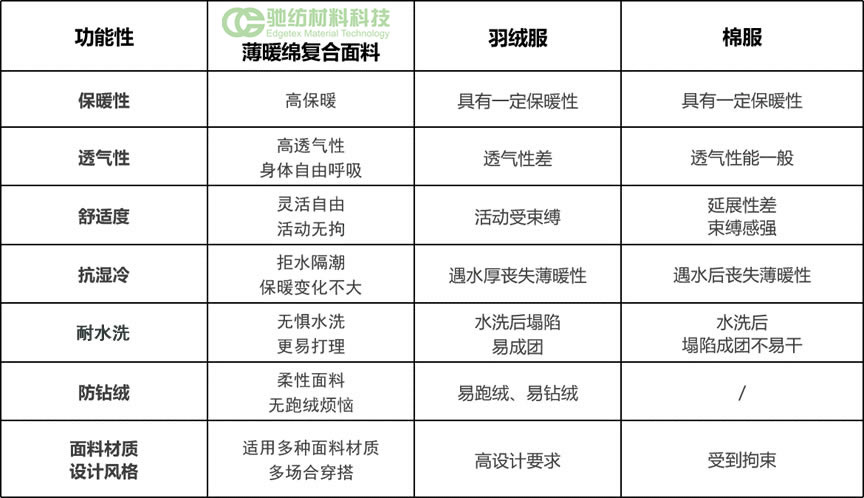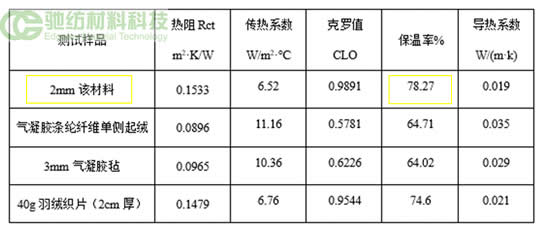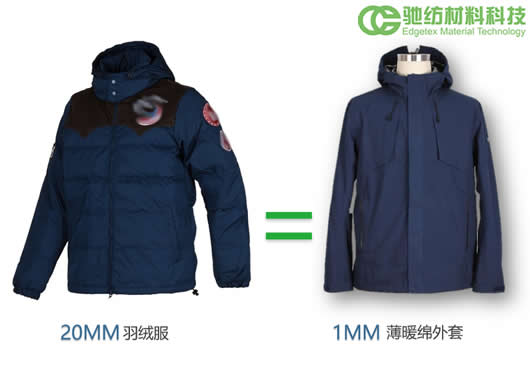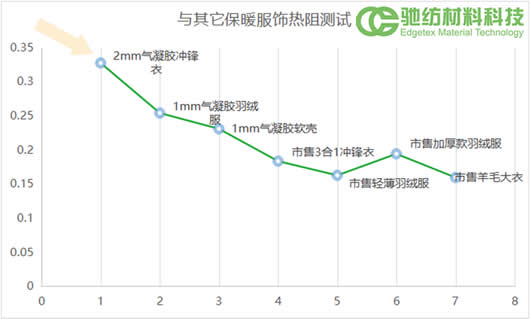With the improvement of my country's economic and living standards, more and more people tend to wear them for leisure and outdoor sports. In the winter clothing consumer market, functional textiles that are warmer and lighter are increasingly favored by consumers.
At present, clothing thermal insulation materials are mainly filled cotton, down, wool and other flakes and filling materials. In order to achieve a higher thermal insulation effect, the thickness of the flakes must be increased to make the product fluffy enough, but this easily causes the wearer to be bloated and inconvenient to move. Natural materials have problems such as easy moisture absorption, poor strength, and easy insects. At the same time, limited production makes them expensive. High-quality down jackets and wool and cashmere coats are easily accepted by the ordinary consumer class. Although synthetic thermal floc has the advantages of wide raw material sources, high strength, water washing resistance, corrosion resistance and moth resistance, its larger fiber diameter makes the material large in pore size and low porosity, which limits the further improvement of its thermal performance.

1. The advantages and disadvantages of common textile insulation materials in the market
Common thermal insulation materials are: down materials, natural wool materials, microfiber thermal materials, cotton thermal materials, meltblown thermal materials, hollow fiber thermal materials, etc.
Different insulation materials have their own unique properties, so that all kinds of materials have their own competitiveness and advantages in the market, but also have their own shortcomings. Mainly from the following two types of analysis:
1. Wool, down and cotton
These three types of warm materials all contain natural warm materials.
Advantages: good ventilation and moisture permeability during wearing, and good warmth retention effect, such as cashmere, duck down, goose down, etc., have the best warmth retention.
Disadvantages: Animal protection organizations frequently report that the above-mentioned materials are suspected of being obtained through animal cruelty, so the world's major brands are also reducing the use of animal fiber.
2. Meltblown thermal insulation materials
Such materials are mainly based on chemical fibers and synthetic fibers.
Advantages: thin and light, good warmth retention.
Disadvantages: The fabric has poor moisture permeability and air permeability. It is easy to generate a large amount of static electricity during wearing and has poor comfort. It is often called a passive insulation material.
3. New thermal insulation and temperature-regulating fibers and textiles
New thermal insulation and temperature-regulating fibers and fabrics are usually made by adding phase-change temperature-regulating materials in the form of microcapsule materials to the spinning dope for spinning, or finishing on the fabric with an adhesive in the form of post-finishing. To absorb and release heat, achieve the purpose of temperature regulation and heat preservation.
Advantages: lightweight and warm
Disadvantages: The heat release effect is not ideal and the durability is poor. Machine washing will affect the heating effect and service life.
2. Chifang's "thin warm cotton" composite fabric has significant warmth retention advantages
The R&D team of Shanghai Chifang Material Technology Co., Ltd. is composed of professors, doctors, and masters from Donghua University, an authoritative institution in the textile industry, and has established technical cooperation relationships with many universities in the industry to develop aerogel textile materials-"thin warm cotton".
As a high-quality aerogel textile material that keeps warm and resists extreme cold, "Thin Warm Sponge" has the remarkable characteristics of "lighter, warmer and more comfortable", and has significant advantages compared with other thermal insulation materials in the market.

Figure 1: Comparison of thermal performance of thin warm cotton
3. Data description of Chifang's "thin warm cotton" high heat preservation data
1. Comparison of physical performance indexes of Chifang's "thin warm cotton" and other warm materials
Thermal resistance test standard: GB/T 11048-2008 Determination of thermal resistance and moisture resistance under steady-state conditions of physiological comfort of textiles:

Figure 2: Comparison of physical performance indicators of thin warm cotton
It can be seen from the above test heat retention rate that the 2 mm "thin warm cotton" composite material has excellent heat retention, which can achieve the warmth retention of a 2 cm thick down jacket, or even better.

2. Test comparison of Chifang "thin warm cotton" aerogel thermal insulation and anti-cold clothing manikin
Thermal resistance data of five series of aerogel thermal insulation and thermal protection manikin, including jacket series, jacket series, wool windbreaker series, mid-length warm windbreaker series, and down style series:
The conditions of the test climate chamber for the manikin: climate room wind: 35HZ; thermal imager test distance 1.25m; emissivity: 0.95; experimental environment: 5℃; humidity: 65%, test board temperature/℃: 33.01

Figure 3: Comparison test of thermal resistance of thin warm cotton
From the above test data, it can be seen that among the thermal insulation clothing sold in the market, only the thick down jacket can barely achieve the thermal insulation effect of the aerogel material, but it is still lower than the aerogel soft shell of only 1mm. It can be seen that Chifang’s “thin warm cotton†truly has incomparable warmth retention. It is perfectly thinner, warmer and more comfortable, and meets people’s high-standard requirements for warm clothing. Looking forward to cooperating with companies that pursue high-quality functional textile fabrics!
Mens Wear,Clothes For Men,Casual Wear For Men,Mens Fashion Clothing
Shaoxing Concord Textile Co., Ltd. , https://www.concordtex.com
